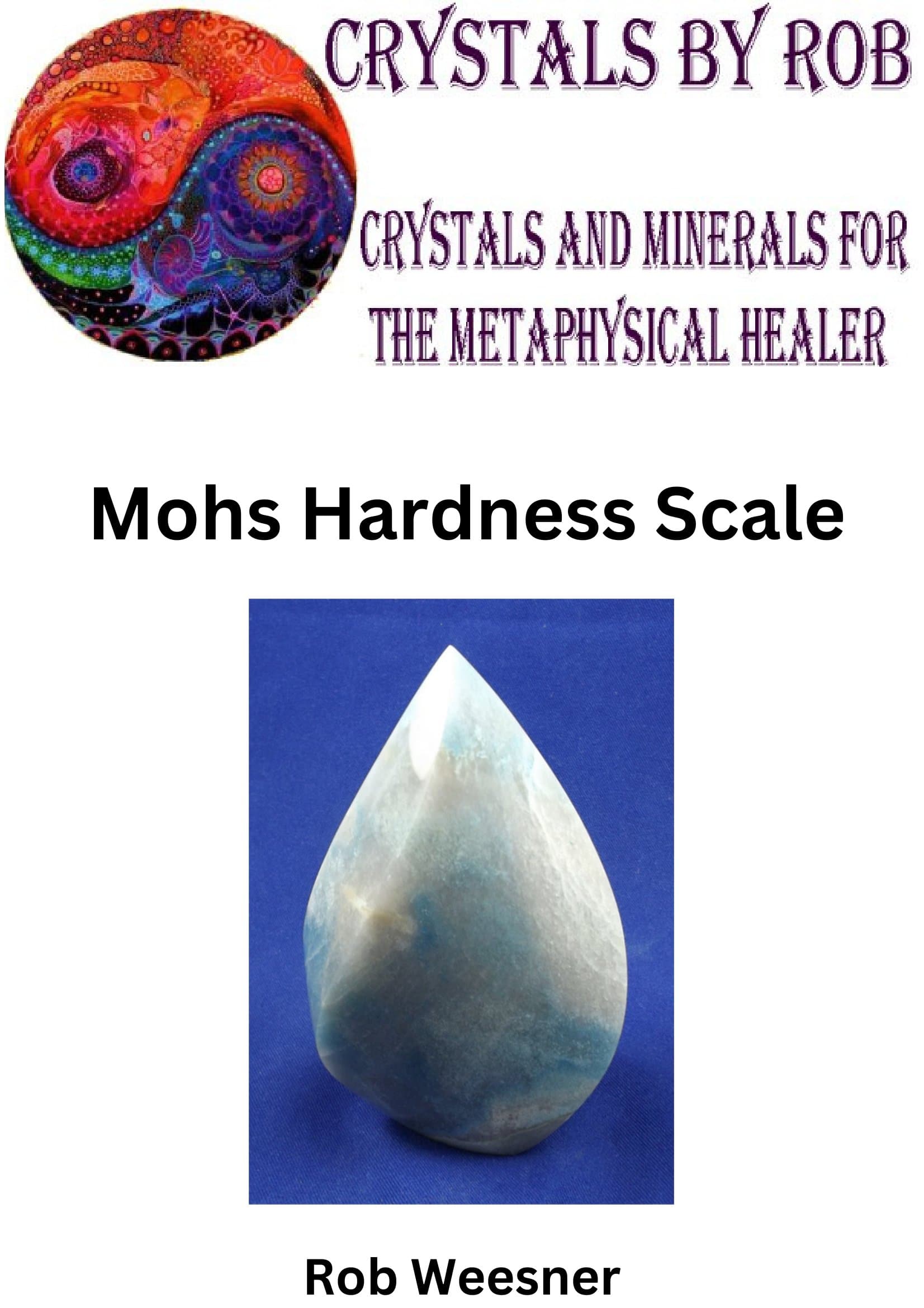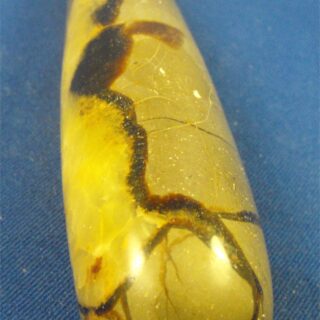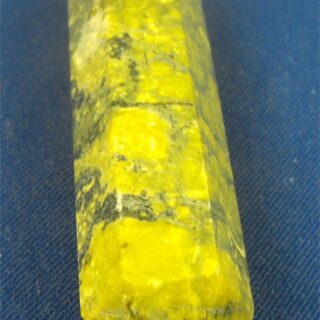Mohs Hardness Scale E book
$5.00
1 x PDF E Book Mohs Hardness Scale
This is a digital download
100000 in stock
Mohs Hardness Scale E book
Mohs Hardness Scale E book, A list of popular crystals with their hardness
The Mohs Hardness Scale is used as a convenient way to help identify minerals. A mineral’s hardness is a measure of its relative resistance to scratching, measured by scratching the mineral against another substance of known hardness on the Mohs Hardness Scale. This graphic outlines the index minerals and some common objects that are used to determine a mineral’s hardness.
This method is especially useful for identifying minerals in the field because you can test minerals against some very common objects (fingernail, a penny, a nail). The scale is named for its creator, the German geologist and mineralogist Friedrich Mohs. However, the method of comparing hardness has been used as far back as 300 BC
How the Mohs Scale Works
If you have a mineral specimen of unknown hardness, and reference mineral #5 can scratch it, then the hardness of your specimen is less than or equal to a Mohs hardness of 5. Similarly, if your specimen cannot be scratched by reference mineral #5, then its hardness is greater than or equal to a Mohs hardness of 5.
By doing successive tests with different reference specimens, you can closely estimate the Mohs hardness of your mineral specimen. The Mohs hardness of a mineral is important information for determining the identity of your specimen.
Mohs Hardness Scale E book
Discovering a Hardness Scale
Friedrich Mohs, a German mineralogist, discovered the hardness scale in 1812. He selected ten minerals of distinctly different hardness that ranged from a very soft mineral (talc) to a very hard mineral (diamond). With the exception of diamond, the minerals are all relatively common, easy to obtain, and inexpensive.
See the accompanying table of the Mohs Hardness Scale minerals. The Mohs Hardness Scale has been used by geologists and geology students for over 200 years. Millions of students have used the Mohs Hardness Test to identify minerals. It is surprising that such a simple test has been in use for over two centuries.
Mohs Hardness Testing Procedure
-
- Begin by locating a smooth, unscratched surface for testing.
-
- With one hand, hold the specimen of unknown hardness firmly against a table top so that the surface to be tested is exposed and accessible. The table top supports the specimen and helps you hold it motionless for the test. (If you are doing this test at a nice desk you may want to get a thick piece of cardboard, a thick rubber pad, or a sheet of some other material to protect the surface from being scratched.)
-
- Hold one of the standard hardness specimens in the other hand and place a point of that specimen against the selected flat surface of the unknown specimen.
-
- Firmly press the point of the standard specimen against the unknown specimen, and with firm pressure, drag the point of the standard specimen across the surface of the unknown specimen.
-
- Examine the surface of the unknown specimen. With a finger, brush away any mineral fragments or powder that was produced. Did the test produce a scratch? Be careful not to confuse mineral powder or residue with a scratch. A scratch will be a distinct groove cut in the mineral surface, not a mark on the surface that wipes away. Use a hand lens to get a good look at what happened.
- Conduct the test a second time to confirm your results.
Related products
-
Agate Geode Point Tower 8 With Amethyst
$154.00Add to cartStone Type: Quartz
Stone Cut: Point / Tower
Stone Weight: 1 Pounds 5.8 Ounces
Stone Size: 3.90 Inches Long x 3.25 Inches Wide
Location: Brazil
-
Septarian Message Wand 1
$20.00Add to cartStone Type: Septarian
Stone Cut: Natural Crystal Wand
Stone Weight: 8.2 Ounces
Stone Color: Brown / Yellow
Stone Size: 6 Inches Long x 1.3 Inches Wide
Location: Madagascar
-
Agate Geode Point Tower 3 With Amethyst
$133.00Add to cartStone Type: Quartz
Stone Cut: Point / Tower
Stone Weight: 1 Pounds 2.7 Ounces
Stone Size: 4.17 Inches Long x 2.98 Inches Wide
Location: Brazil
-
Serpentine Message Wand 1
$15.00Add to cartStone Type: Serpentine
Stone Cut: Natural Crystal Wand
Stone Weight: 2.9 Ounces
Stone Color: Green
Stone Size: 3.95 Inches Long x .92 Inches Wide
Location: Brazil
Recent Blog Posts
- Metaphysical Healing Properties Of Celestobarite
- History Of Yellow Fluorite
- History Of Green Calcite
- History Of Blue Calcite
- History Of Purple Fluorite
- History Of Green Fluorite
- History Of Orange Calcite
- History Of Black Tourmaline
- History Of Celestite
- Metaphysical Healing Properties Of Black Tourmaline With Hematite
- Metaphysical Healing Properties Of Blue Tigers Eye
- Metaphysical Healing Properties Of Yellow Tibetan Quartz
Blog Categories
- Aura
- Books
- Chakras
- Creating Intention Bowls
- Crystal – Programming, Cleansing, Chakra Info
- Crystal Grids
- Crystals And Angels
- Crystals Related To Deity Spirit Guides
- Elements
- Feng Shui
- Geological Properties Of Crystals
- History Of Crystals
- Incense – The History Of, How To Make, And Incense Recipes
- Manifesting
- Meridians
- Metaphysical Properties Of Crystals And Stones
- Properties Of The Shapes Of Stones
- Reiki Articles
- Rituals
- Sacred Geometry
- Sacred Space
- Sound Healing
- Stones For Ailments
- Top Stones Lists
- Uncategorized
- Uses Of Crystals In Religion
- Video Blogs
- Actinolite33 products
- Agate7474 products
- Ajoite33 products
- Alantisite11 product
- Amazonite11 product
- Amber55 products
- Amegreen11 product
- Amethyst6262 products
- Amethyst Stalactite22 products
- Ammonite Necklaces11 product
- Amphibole In Quartz2323 products
- Angel Aura Quartz44 products
- Angel Phantom Quartz55 products
- Angel Tuning Forks Sound Healing Session11 product
- Angelic Crystal Energy Attunements1717 products
- Angelite11 product
- Apache Tears11 product
- Apatite11 product
- Apophyllite44 products
- Apophyllite With Stilbite22 products
- Apple Green Aura Quartz11 product
- Aqua Aura Quartz11 product
- Aquamarine33 products
- Aragonite44 products
- Arcturian Reiki Attunement22 products
- Arkansas Quartz1010 products
- Aura Balancing Distant Healing11 product
- Aura Quartz Crystals66 products
- Auralite44 products
- Aventurine33 products
- Banded Black Agate22 products
- Beads88 products
- Black Tourmaline88 products
- Bloodstone11 product
- Blue Lace Agate33 products
- Book Of Shadow Pages4545 products
- Books On Crystals1616 products
- Botswana Agate33 products
- Cabochons1919 products
- Calcite1818 products
- Candle Quartz99 products
- Carnelian44 products
- Carved Penis Crystals11 product
- Celestite33 products
- Chakra88 products
- Chakra Grids22 products
- Chalcedony55 products
- Charoite11 product
- Chiastolite66 products
- Chlorite99 products
- Chlorite Lemurian Crystals66 products
- Chrysocolla33 products
- Citrine1212 products
- Clam Shell Jasper44 products
- Clear Lemurian Crystals66 products
- Clear Quartz2121 products
- Coffins33 products
- Coprolite22 products
- Coral11 product
- Crystal Balls / Spheres130130 products
- Crystal Eggs3131 products
- Crystal Grid Distant Healing22 products
- Crystal Healing Course11 product
- Crystal Notes11 product
- Crystal Reiki Session11 product
- Cut And Polished6161 products
- Danburite22 products
- Dendritic Opal11 product
- Dendritic Quartz22 products
- Desert Rose22 products
- Diamantina Quartz Crystals44 products
- Diaspore11 product
- Dragi Jade11 product
- Dragons Blood Jasper44 products
- Druzy Quartz33 products
- Dumortierite11 product
- Elestial Quartz Crystals66 products
- Energetic Protection From Negative Energy Session11 product
- Energy Healing11 product
- Euchlorite88 products
- Fenster Quartz22 products
- Fire Amphibole66 products
- Flames55 products
- Flower Agate44 products
- Fluorite3434 products
- Garnet22 products
- Garnet In Schist11 product
- Geodes1616 products
- Girasol11 product
- Golden Healer3434 products
- Grape Agate22 products
- Green Chert11 product
- Green Opal22 products
- Halite11 product
- Hearts3434 products
- Hematite77 products
- Hickoryite22 products
- Honey Calcite33 products
- Included Quartz2020 products
- Included Quartz Free Form Prisms99 products
- Indigo Gabbro44 products
- Intention Bowls44 products
- Ironstone11 product
- Jade99 products
- Jasper2929 products
- Kammererite11 product
- Labradorite55 products
- Lake Superior Agate44 products
- Lapis Lazuli22 products
- Larvikite11 product
- Laser Wand Crystals33 products
- Lemon Quartz11 product
- Lemurian Quartz Crystals3434 products
- Lepidolite33 products
- Lithium Quartz Crystals1010 products
- Lodolite Quartz Crystals33 products
- Love Bowls11 product
- Malachite11 product
- Manganese Included Quartz44 products
- Message Wands1010 products
- Mini Spheres2121 products
- Montana Agate22 products
- Mookaite11 product
- Moon Ritual Bowls11 product
- Moon Shaped Crystals66 products
- Moonstone22 products
- Moss Agate33 products
- Mystic Merlinite44 products
- Necklaces3333 products
- Nirvana Quartz11 product
- Obsidian99 products
- Ocean Jasper55 products
- Opal99 products
- Opalite22 products
- Orca Agate1010 products
- Palm Wood33 products
- Peach Quartz55 products
- Pecos Diamonds33 products
- Pendulum Reading11 product
- Pendulums11 product
- Petrified Wood55 products
- Phantom Quartz33 products
- Phoenix Stone44 products
- Pietersite11 product
- Pineapple Quartz11 product
- Pink Amethyst22 products
- Pink Lemurian99 products
- Pink Thulite & Scapolite22 products
- Prasem33 products
- Prehnite33 products
- Quantum Quattro Silica11 product
- Quartz Crystal Clusters1313 products
- Quartz Crystal Points104104 products
- Rain Forest Jasper55 products
- Rainbow Obsidian44 products
- Red Hematoid Quartz Crystals1919 products
- Red Plum Blossom Jade77 products
- Red Tanzurine Quartz44 products
- Removing Negative Energies Bowl11 product
- Rhodonite55 products
- Riebeckite In Quartz11 product
- Rose Quartz1111 products
- Ruby88 products
- Ruby And Tourmaline In Quartz11 product
- Ruby In Fuchsite11 product
- Ruby In Kyanite33 products
- Ruby In Zoisite22 products
- Rutilated Quartz22 products
- Selenite1313 products
- Septarian1010 products
- Serpentine44 products
- Shiva Lingam11 product
- Shungite33 products
- Singing Quartz Crystals11 product
- Skulls33 products
- Smoky Lemurian Crystals1717 products
- Smoky Quartz Cluster22 products
- Smoky Quartz Crystals2929 products
- Snowflake Obsidian11 product
- Solar Eclipse Bowl11 product
- Spectrolite11 product
- Spessartite Garnet On Smokey Quartz11 product
- Spirit Quartz3737 products
- Starbrary Crystals55 products
- Strawberry Quartz Crystals88 products
- Stromatolite22 products
- Subscription Service11 product
- Sunstone22 products
- Super Seven44 products
- Tangerine Quartz44 products
- Tarot Cards11 product
- Tianshan Blue55 products
- Tibetan Quartz99 products
- Tiffany Stone3131 products
- Tigers Eye22 products
- Tourmaline22 products
- Tourmaline In Albite2020 products
- Tourmaline In Quartz55 products
- Towers4545 products
- Tremolite11 product
- Trolleite11 product
- Tumbled Stone Necklaces1010 products
- Tumbled Stones106106 products
- Unakite33 products
- Utah Mineral Flats77 products
- Utah Topaz Crystals11 product
- Variscite22 products
- Vesuvianite11 product
- Yavapai33 products
- Yellow Hematoid Quartz2424 products
- Yellow Quartz22 products
- Yellow Skin Agate55 products
- Youngite11 product





